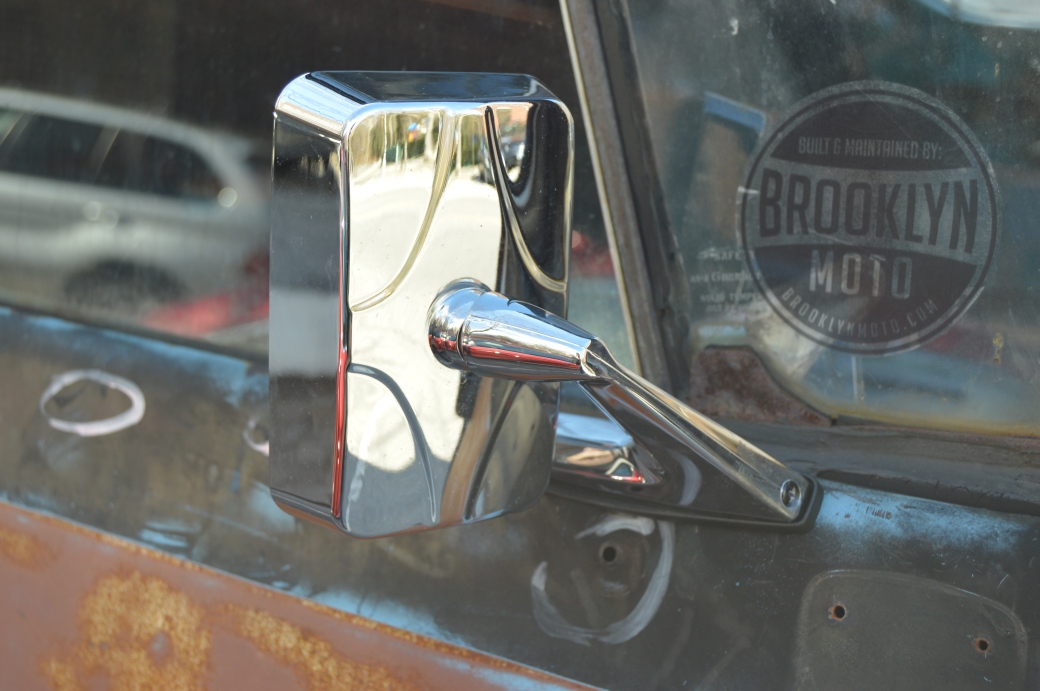
There’s something strange about finding yourself north of 250th street. It feels like that scene in The Royal Tennenbaums where they say they live on 375th street. Like magical realism. People live in houses up here. Real, honest-to-God houses, with driveways and everything. In a similar way, it’s funny to see a van this old out in the wild. Vans are utilitarian objects: tools that serve a purpose and are then disposed of. I don’t know if the owner of this car is keeping it running in earnest or if they just drive it ironically. Who knows? We’re in uncharted territory for many New Yorkers. This is a 1969 ChevyVan.

We’ve talked about vans made by Chevrolet before on Forgotten Metal, but never the ChevyVan. Yes, this is a “not all rectangles are squares” situation, so let’s take a second to get our nomenclature right. At the moment, General Motors sells a van called the Chevy Express, which has been around since the mid-nineties and is probably familiar to some of you. Before that, their offering was called, simply, the Chevy Van. Before that was this: the ChevyVan. While it may seem like a subtle change, the evolution from ChevyVan to Chevy Van was a big one. And it all started with where they chose to mount the engine.

Most vans today make use of what’s called an “FR” layout. That means the engine is mounted at the front of the vehicle, and a driveshaft sends power to the rear wheels. The ChevyVan, however, is arranged in an FMR layout. The rear wheels still power the vehicle, but the engine is located just behind the front axle, making it a front-mid engine setup. FMR layouts are mostly used in sports cars with long engines, like the Honda S2000 and the Ferrari F12. See how the engine is mounted in front of the passenger compartment but behind the front wheels? That’s FMR in a nutshell. It makes sense when we’re talking about sports cars, where terms like “weight transfer” and “center of gravity” are important. But van drivers generally don’t need to concern themselves with how fast they can take Eau Rouge at Spa (though there have been notable exceptions to that rule). Which is what makes the fact that Chevy produced a van with an FMR layout so interesting.

Another feature you may have noticed is that the ChevyVan lacks any discernible hood- the front end is almost completely flat. Which begs the question: if the engine has to be located behind the front wheels, but there’s no long hood to accommodate it, where does the engine go? Moreover, where does the driver sit? If for some reason you took a shot in the dark and said, “on top of the engine,” then congratulations! You’ve won some extremely covetable and totally worthless Forgotten Metal Points™. That’s right: to operate a ChevyVan, you had to sit atop a machine that harnessed the power of thousands of tiny consecutive gasoline explosions. And people say vans are boring. The engine in question could be an inline-6 or a V8. Power output hovered between 140 and 200 horsepower, though in 1970 Chevrolet offered a 255 horsepower, 350-cubic inch V8. In terms of transmissions, you could have a four speed manual (mounted on the steering column!) or a three speed automatic known, delightfully, as the “Turbo-Hydramatic.”

With the ChevyVan, General Motors entered the prestigious ranks of manufacturers-who’ve-offered-a-van-with-the-engine-in-a-weird-place. It’s an exclusive club- Toyota is also a card-carrying member. Again, I’m not sure what the deal is with this particular example. I don’t know if the owner painted it that way or if they’re in the process of choosing between, I guess, three or four different colors. Despite the mystery, or perhaps because of it, this ChevyVan has charm. Which is exactly what you’re looking for when you’re wandering around the northernmost reaches of… I want to say Riverdale? Hudson Hill? Where am I?
Additional Thoughts:
- Though you can’t tell on this particular example, 1969 was the year that Chevy started painting their logo blue on ChevyVans. Previously it was red.
- The ChevyVan had an air-conditioning system, but it was mounted on the ceiling for some reason. Curiouser and curiouser.
- This is actually the second generation of ChevyVan. The first generation was a little smaller, had its headlights mounted higher, and was not available with a V8.
That looks like the fan of a serial killer. Stay away!
LikeLike
Van, not fan. Sorry for my typo.
LikeLike
Haha- you’ve been reading too much “Beyond The Mortal Coil!”
LikeLike